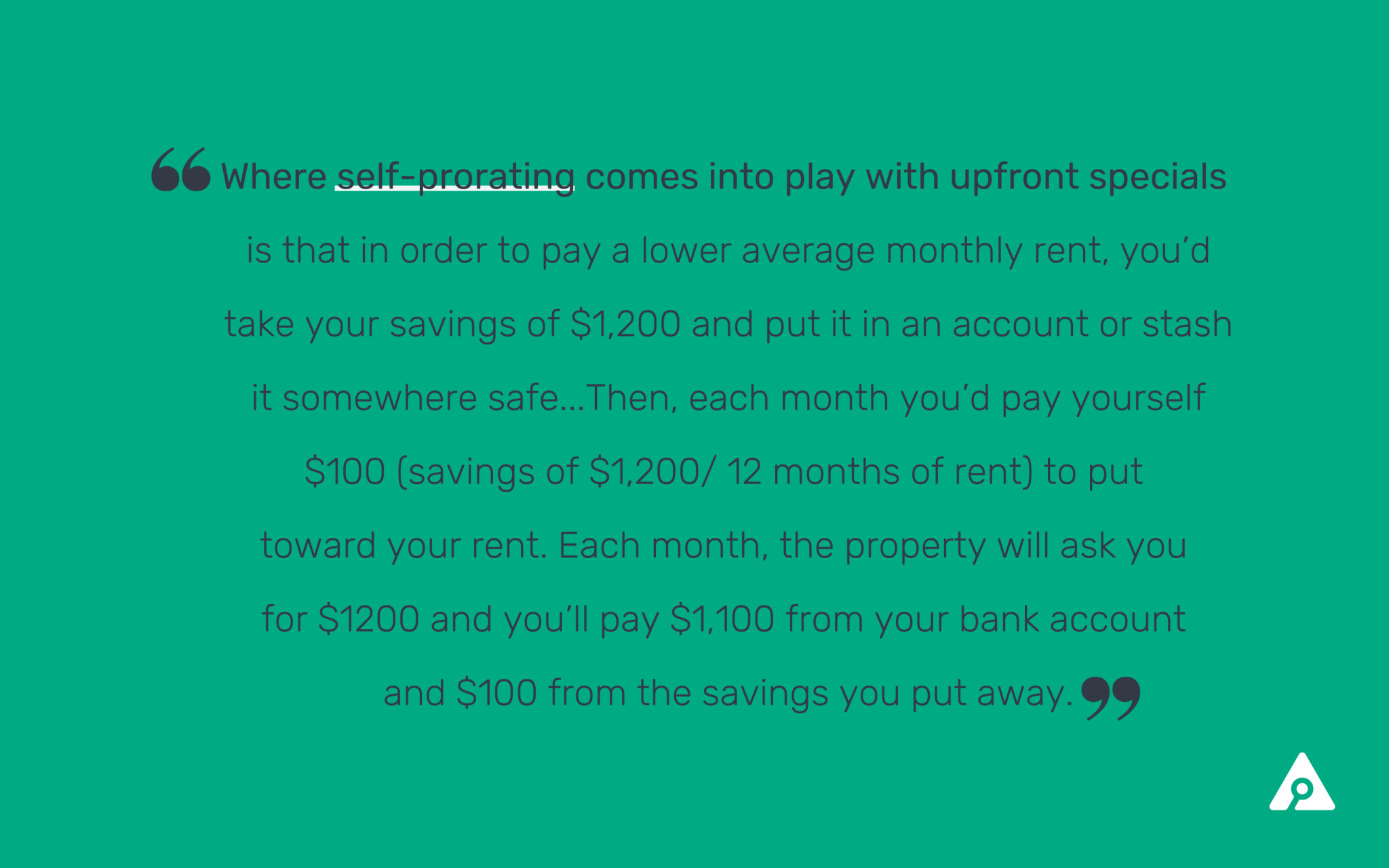Specials, Concessions and Self-Prorating: What does that even mean?

We pride ourselves on being able to find our clients the best apartment deals in their cities. The main way we do this is by finding or negotiating the best specials and concessions around. Specials and concessions are great because they level the playing field when it comes to what is classified as “affordable” for our clients; better said – it gives them more options to tour and choose from!
At a base level, specials and concessions are fairly straightforward – they offer prospective tenants reduced pricing. It’s getting into upfront specials versus pro-rated specials, or application approval based on market or effective rates, or how to calculate your overall savings or what account credits and self-prorating are that can make it confusing.
Believe us, we’ve been there, too! Working for Smart City made us more knowledgeable renters and we’re here to do the same for you. It all boils down to understanding specials, concessions, and how to self-prorate.

Understanding specials and concessions
A special or concession is a reduction in price or accompanied incentive that will benefit the prospective tenant. These can read anywhere from “X weeks free” to “X months free” to “first month free” to “$XX move-in” to “free parking for X months,” so on, and so forth.
These types of incentives can be classified into two categories – upfront or prorated. An upfront special/concession means it’s awarded all at once (example: First month free). A prorated special/concession means it’s dispersed (prorated) over a period of time, typically throughout the designated lease term. Sometimes the property will prorate on the tenant’s behalf, bringing the cost of rent each month down an incremental amount, and sometimes they’ll place it as a credit on the account for the tenant to put toward rent each month themselves. We explain this more in the section below!
Prorated specials, upfront specials (read: self-prorating), and applied credits
Properties will apply specials in one of three ways – prorated, applied as a credit, or upfront. Let’s use the scenario above as an example to explain each avenue.
A prorated special means the property has already deducted average monthly savings and each month when you go to pay rent you’ll only see the lower effective rent as the due amount instead of the market rate.
An upfront special (read: self-prorating) means that the property applies the savings at the beginning of your lease. So, in the scenario above, a total savings of one month free ($1,200), applied upfront would be put toward monthly rent payments of the market rate of $1,200. Essentially, you’d pay nothing for your first month. Then, your 2-12 months’ payments would be the market rate of $1,200 each month.
Where self-prorating comes into play with upfront specials is that in order to pay a lower average monthly rent, you’d take your savings of $1,200 and put it in an account or stash it somewhere safe. Put it in a savings account, a piggy bank, in an envelope, or whatever form of money coveting you choose. Then, each month you’d pay yourself $100 (savings of $1,200/ 12 months of rent) to put toward your rent. How sway? *Kanye voice* The property will ask you for $1200 and you’ll pay $1,100 from your bank account and $100 from the savings you put away! BAM, self-prorating made easy; you’re welcome.
An applied credit means the property has placed funds in your account for you to put toward your rent payment throughout your lease. So, you’ll see a due amount of the market rate ($1,200) but have the total savings from the applied special ($1,200) to bring down what you’re paying effectively. You can apply it evenly throughout your lease or apply lump sums at a preferred cadence of your discretion.
Calculating savings from an offered special/concession
As a prelude to calculating specials, let’s chat for a second about “market rate” and “net effective rent.” The market rate is what pricing is before any specials are applied (if any are available). Net effective rent, mostly referred to only as effective rent, is the monthly amount that is paid after a special/concession is applied to the lease term. Now that we’re clear on that, let’s use the scenario above to calculate savings!
To see what you’ll be saving/paying each month, you’ll take the market rent and divide it by the number of months in your lease term.
$1,200 / 12 months = $100 saved each month. This takes your effective rent down by $100/month to $1,100 per month on a 12-month lease!
If the special is based on a number of weeks, such as “6 weeks free,” you’ll use four easy steps:
1) First, multiply the market rent by the number of months in the lease term.
$1,200/month x 12-month lease= $14,400 total
2) Then, divide that number by the number of weeks in the lease term.
$14,400/ 52 weeks (in 12 months)= $276.92.
3) Now, multiply that by the number of weeks that apply to the special.
$276.92 x 6 (weeks free)= $1,661.54 total savings throughout your 12-month lease
*If it were a 10-month lease, you’d divide by 40 weeks; a 15-month lease, you’d divide by 60 weeks, and so on to get your total savings.
4) Then, to see your effective rent each month after the special, you’ll divide the last number by the number of months in the lease and subtract that from the market rate.
$1,661.54/ 12-month lease= $138.46
$1,200 market rate – $138.46= $1,061.54 effective monthly rent!

An important note about specials and getting approved for an apartment
Now that we’ve covered the types of specials/concessions that are out there, how to calculate anticipated savings from them and what market/effective rents are, let’s touch on the application process for a moment. While it’s exciting to note effective rent after a special has been applied, it’s important to also note the market rate, as well. The reason being that properties will either qualify you (approve you) for that apartment based on the market rate or on the effective rent once you apply.
Typically, properties qualify (approve) applicants based on market rates, and remember, the general rule of thumb to get approved for an apartment is to show financial documents proving income of 3x the rent. If you’re working with a Smart City agent, this is something they’ll walk you through, but even if you’re not, we wanted to make sure to cover it because that’s generally something that doesn’t get talked about as much as the deals do.
The area in which we see renters get caught up on this the most is when properties with higher market rates offer a multi-month special. While getting 2-plus months free can bring effective pricing down to a very alluring monthly rate, the approval could still be based on proving finances equating to 3x the monthly market rate. So, whether you’re working with an apartment locator or not, this is valuable information for any apartment renter to know!
Who knew saving money could require so much work, right?! At the end of the day, rent is most people’s biggest monthly expense, so every bit of savings is definitely worth it! Hopefully, this blog brought clarity around specials, concessions, and what it means when you have to self-prorate!
If you’re over finding and calculating apartment specials, let us know – You’ll end up gaining hours and hours back to your life (which is a “saver” all in itself)!







